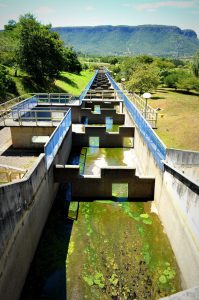Protecting “the heartbeat of the Amazon”
The heartbeat of the Amazon River is in danger of being silenced as hundreds of new dams are being built or planned in coming years, University of Florida researchers say in a new paper published Nov. 1 in the journal Science Advances.

University of Florida PhD students at the reservoir formed by the Santo Antônio Dam on the Madeira River. Photo by Christine Swanson.
David Kaplan, an assistant professor of environmental engineering, and Kelsie Timpe, a former graduate student who co-authored the paper with Kaplan, studied the effects of existing dams and used the data to predict how the river’s natural flooding cycles — vital to the health of the Amazon and its flora and fauna — would suffer.
The prognosis, they say, is not good.
“The flood pulse is the heartbeat of the Amazon, and dams severely disrupt that pulse,” Kaplan said.

A fish ladder at the Lajeado (Luís Eduardo Magalhães) Dam. The efficacy of the ladder has been extremely low. Photo by Kelsie Timpe.
While all dams have an impact on the hydrologic regime, he said, some dams are much worse than others; analyzing the hydrologic impacts of all existing Amazon dams helped the team understand some of the major predictors of impact, which can be used to predict — and hopefully reduce — the impacts of future planned dams.
Surprisingly, Kaplan said, “small” dams had exceedingly large impacts relative to their energy production potential.
“This is troubling,” he said, “because these smaller systems often face much less stringent permitting and monitoring requirements. Our study is also the first to show how multiple dams on a single river interact to change hydrology and ecosystem function.”
The research is part of Kaplan’s collaboration with the Amazon Dams Network, an international, interdisciplinary group of researchers and other stakeholders around the world focused on improving understanding of the effects of Amazon dams across social and environmental systems.
